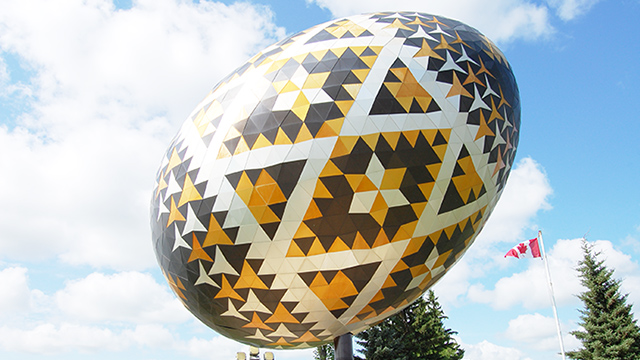
"When I look at a pysanka, take for example the metal egg that is found at the entrance to Vegreville, I see mathematics: fractions, lines and symmetry, parallel and perpendicular lines, and transformations (translations, rotations and reflections)," said Yvette d'Entremont.
Another Conversation on Research took place on April 8th, and this was an opportunity for Yvette d'Entremont to demonstrate that mathematics is part of our daily lives and has a direct link to artistic creations.
To begin her presentation, the Senior Associate Dean of Academic Affairs said, "It would probably be easier to teach mathematics to a group of students with similar abilities in this domain, the same learning styles and the same cultural realities. However, how boring that would be!''
According to her, it can be easy to make mathematics interesting if we just put a little bit of effort. She draws from her personal experience and, more specifically, from the beginning of her teaching career in Wedgeport, Nova Scotia. "I was teaching at a high school and the students were not too interested in trigonometric functions. I managed to motivate them by using the cultural activities of the fishing village; for example, I asked them to find the distance between two key locations of the village. They quickly demonstrated an interest in this subject. We must not overlook the community culture that surrounds us when it comes to mathematics, "said Mrs. d'Entremont.
This example can be easily transposed today. "Students differ in their sociocultural background and their cultural values. This diversified background makes teaching more interesting and challenging. In my opinion, it is essential to make connections that integrate cultural the heritage of students to teaching mathematics, "says Yvette d'Entremont.
For this Professor, ethno-mathematics, which is the study of the interaction between mathematics and culture, is essential. "Teachers must know their students, not just in terms of their mathematical knowledge, but also in terms of their everyday life experience. This also leads to the acquisition of deep and conceptual knowledge, and not just the memorization of the quadratic formula," she says.
Research shows that the study of mathematics oriented towards ethno mathematics helps students acquire the knowledge and skills essential to understanding the mathematical aspect of their culture and other cultures. It can be found in agriculture, fishing, sewing, cooking, architecture, art and crafts and much more...
Quilts, pysankas and basket weaving
To illustrate her point, Yvette d'Entremont presented part of her research that links mathematics to art and crafts.
In many cultures, making a quilt is a tradition that is passed from generation to generation; it has historical and artistic values. According to Mrs. d'Entremont, its creation is mathematical in nature as well. "When I see a quilt, I see several mathematical concepts such as estimation, measurement, area, perimeter, fractions, proportions, shapes, symmetry, reflection, rotation, and more," she enumerates.
Pysankas are another good example. For many, it is a cultural tradition while the motifs and the colours of each egg are used to express a strong attachment between the earth and the natural elements while the symbol of each egg has an important meaning. "When I look at a pysanka, take for example the metal egg that is found at the entrance to Vegreville, I see mathematics: fractions, lines and symmetry, parallel and perpendicular lines, and transformations (translations, rotations and reflections)," said Yvette d'Entremont.
Basket weaving
Being very interested in Mi'kmaq baskets, Yvette d'Entremont went to Prince Edward Island in May 2011 and May 2013 to interview Marjorie Paul, a Mi'kmaq woman who weaves baskets, to understand how the artist uses math in her artistic creations. "Her first reaction was: 'I do not do math!' Throughout our discussions, she realized without knowing it that she was doing mathematics," she argues.
Indeed, the process of creating a basket starts with wooden slats. To determine the size of the basket, it uses a single unit of measurement: her hands. So a slat having two, four, six or eight times her hand length. Then she cuts her slats in two, four or eight.
This woman, who did not finish high school, was one of the 90 First Nations artists selected to create a work of art for the Vancouver 2010 Olympics. She created a 7 feet by 6 feet piece. It was that particular size because it was the size of the room where the object was built. She found the central point of this piece by attaching two diagonal ropes.
"When you look at the process she uses for each of her pieces, you realize she is doing mathematics, a lot of mathematics, but without even realizing it. Marjorie Paul Lewis puts into practice the mathematical principles she learned orally and visually by practising basket weaving with her parents and grandparents. According to her, basket weaving is the transmission of a culture. The question is, how we can learn from this woman in order to teach math so that the use of mathematics becomes a natural activity, and not a painful one." Yvette d'Entremont questions.
As she points out, cultural diversity is powerful. "The creation of mathematical activities based on traditional symbols, whether quilts, pysankas or basket weaving, is essential in the classroom. Educational curriculum designers and teachers should consider this diversity to enhance the learning of mathematics through social and cultural activities," she says.
"Given that in the classroom, cultural diversity is an increasingly common phenomenon, it is important that schools create an environment conducive to cultural exchange," concludes Yvette d'Entremont.